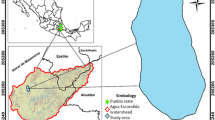Abstract
Resins are an abundant and varied resource in the wet tropical forests of Southeast Asia. These exudates have been found archaeologically in Malaysia and are still exploited extensively by indigenous peoples. This paper analyzes the system of plant classification used by the Semelai of Tasek Bera who still exploit in many traditional ways their local forest resources. Two types of English terminological usage are presented in order to facilitate description of the Semelai classification system. Their complex and interlocking categories reflect the large range of useful, natural substances found in their local environment. It is concluded that an understanding of their classification of plant fluids, which is largely based upon gross morphological features, also requires a knowledge of Semelai torch technology.
Similar content being viewed by others
Literature cited
Beck, C. W., E. Wilbur, and S. Meret. 1964 Infra-red spectra and the origin of amber. Nature 201: 256–257.
Berlin, B., D. Breedlove, and P. Raven. 1968 Covert categories and folk taxonomies. Amer. Anthropol. 70: 290–299.
Bowden, B. F., and B. Reynolds. 1982 The chromatographic analysis of ethnographic resins. Newslett, Austral. Inst. Aboriginal Stud. 18.
Burkill, I. H. 1966(1935). A Dictionary of the Economic Products of the Malay Peninsula. Crown Agents for the Colonies, London.
Conklin, H. C. 1982 Ethnoarchaeology: An ethnographer’s viewpoint.In E. Tooker, ed, Ethnography by Archaeologists, 1978 Proc. Amer. Ethnol. Soc, p. 11–17. Amer. Ethnol. Soc, Washington, DC.
Dempwolff, O. 1938 Vergleichende Lautlehre des Austronesischen Wortschatzes III. Z. fur Einge-borenen-Sprachen, Beiheft 19, Berlin.
Dunn, F. L. 1964 Excavations at Gua Kechil, Pahang. J. Malaysian Branch, Royal Asiatic Soc. 37: 87–124.
Evans, I. H. N. 1928 On ancient remains from Kuala Selinsing, Perak. J. Fed. Malay States Mus. 9: 16–33.
Gianno, R. 1985 Semelai Resin Technology. Ph.D. Diss. Yale Univ., New Haven, CT.
—, and K. M. Kochummen. 1981 Notes on some minor forest products. Malaysian Forester 44: 566–568.
Lamb, A. 1961 Research at Pengkalan Bujang; A preliminary report. Fed. Mus. J. 6: 21–37.
Langenheim, J. H. 1969 Amber: A botanical inquiry. Science 163: 1157–1169.
—, and C. A. Balser. 1975 Botanical origin of resin objects from aboriginal Costa Rica. Vinculos: Revista Antropol. Mus. Nac. Costa Rica 1: 72–82.
Mills, J. S., and R. White. 1977 Natural resins of art and archaeology: Their sources, chemistry and identification. Stud. Conserv. 22: 12–31.
McKinnon, E. E., and Tengku Luckman Sinar S. H. 1974 Kota China: Notes on further developments at Kota China [North Sumatra]. Berita Kajian Sumatera 4: 63–86.
Poore, M. E. D. 1968 Studies in Malaysian rain forest. 1. The forests on Triassic sediments in Jengka forest reserve sediments in Jengka forest reserve. J. Ecol. 56: 143–196.
Taylor, P. M. 1980 Tobelorese Ethnobiology: The Folk Classification of Biotic Forms. Ph.D. Diss. Yale Univ., New Haven, CT.
Tweedie, M. W. F. 1936 Report on cave excavations carried out in Bukit Chintamani, near Bentong, Pahang. Bull. Raffles Mus., Ser. B 1: 17–25.
—. 1937 Minor excavations carried out in caves in Pahang and Johore. Bull. Raffles Museum, Ser. B 1: 154–155.
—. 1953 The excavation at Tanjong Bunga. Appen. 3 of The Stone Age in Malaya. J. Malaysian Branch, Royal Asiatic Soc. 26: 84–85.
Wang, S., and J. B. Huffman. 1981 Botanochemicals: Supplements to petrochemicals. Econ. Bot. 35: 369–382.
Watt, G. 1889–1896. A Dictionary of the Economic Products of India. 7 vol. Superintendent Gov. Printing, Calcutta, India.
Whitmore, T. C. 1975 Tropical Rain Forests of the Far East. Clarendon Press, Oxford, England.
Wolters, O. W. 1960 ThePo-ssu pine trees. Bull. School Orient. African Stud. 23: 323–350.
—. 1967 Early Indonesian Commerce. Cornell Univ. Press, Ithaca, NY.
Author information
Authors and Affiliations
Rights and permissions
About this article
Cite this article
Gianno, R. Resin classification among the Semelai of Tasek Bera, Pahang, Malaysia. Econ Bot 40, 186–200 (1986). https://doi.org/10.1007/BF02859143
Received:
Accepted:
Issue Date:
DOI: https://doi.org/10.1007/BF02859143




